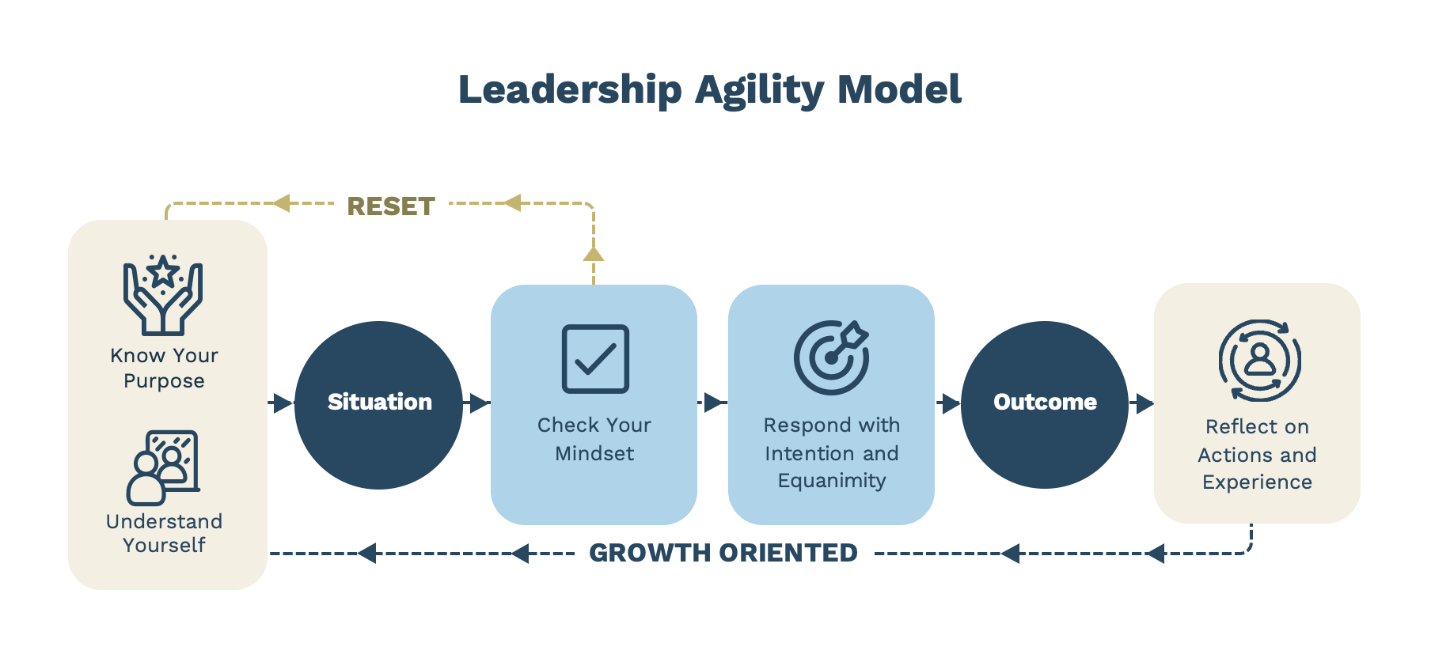In a recent Harvard Business Review article, author Ron Ashkenas labeled agility the “leadership superpower.” His article begins, “One of the most lauded leadership characteristics today is the ability to pivot—to change course quickly when a planned path is blocked or revealed to be disadvantageous. This kind of rapid adaptation, often referred to as agility, is critical in a fast-changing environment or when innovating in unknown territory where old behaviors and management practices no longer work.”
I agree that agility is an extremely important skill for today’s leaders. I also believe that in addition to the change and innovation-centered context described by Mr. Ashkenas, leadership agility is needed in addressing the wide-ranging, people-centered challenges leaders face nearly every day. In today’s tumultuous workplace—where so many situations are complex, uncertain, and highly fluid—leaders must be open to new ways of thinking and working. Instead of leadership agility being characterized as a rare superpower, I think we need to begin thinking of it as a fundamental leadership competency.
Agility in a leadership context involves taking action and making decisions that move the business forward in the face of uncertainty and change. It requires creativity, flexibility, and innovation as well as deliberate action. It relies on a leader’s ability to manage change, conflict, and resources to solve problems and achieve goals.
Over the last year, my colleagues and I at Dion Leadership have been researching and studying leadership agility. Our findings consistently show that agility is a connector skill, or ultimately, an outcome of the application of a set of competencies—a “meta-competency” of sorts.
Leadership agility connects to these important skills:
Flexibility
Adaptability
Mindfulness
The ability to act with incomplete information
And like all leadership skills, it can be developed.
So how do we, as human resource professionals, develop our leadership agility? And how do we help the leaders in our organization develop their agility skills?
Leadership agility is about creating space in your brain so that when faced with circumstances that are new, changeable, and uncertain, you’re more likely to respond thoughtfully, rationally, and with intent.
This simple yet comprehensive model will help.

You’ll notice that this model is circular, indicating it is a development process designed to be repeated. The illustration also shows that developing your leadership agility is primarily a self-reflective process.
The first steps are knowing your purpose within your team or organization and understanding yourself. Knowing your purpose is about grounding yourself in what needs to be accomplished and the parameters that guide projects, initiatives, and even the organization overall.
Similarly, understanding yourself requires clarity on what you bring to the situation as a leader—your personal style and tendencies, comfort zone, and strengths and limitations, as well as knowledge of what drives you, what stresses you, and other qualities that inform your self-awareness.
The middle section is about what happens when you’re faced with a situation that will call on your leadership agility to drive favorable outcomes. This involves checking the mindset that you bring to the situation. This in-the-moment analysis considers whether your mindset aligns with the achievement of a productive, effective outcome that benefits you, the initiative, and the organization. If it doesn’t, you will need a reset so you can respond to the situation in a way that is thoughtful, intentional, deliberate, equanimous, and compatible with a positive result. Returning to what you know about your purpose and yourself can inform this mindset shift before taking action to facilitate the outcome.
What closes the circle is reflection on lessons learned about the process and your behavior. With a spirit of self-awareness and growth orientation, this reflection further refines your purpose and mindset.
How would you rate your leadership agility competency? Consider these questions:
Is the work I do grounded in the company’s purpose, goals, and values?
Is the work I do day-to-day guided by my personal sense of purpose in my role, goals, and values?
Do I regularly focus on improving my emotional intelligence?
Am I able to be productive and effective in uncertain or changeable work situations?
Do I regularly step back and consider a broader perspective when I approach work challenges and opportunities?
Do I check in with my mindset as part of my approach to workplace challenges and opportunities?
Would I typically describe my mindset as growth oriented?
Am I willing to consider new ways and ideas, even if they are not my own and are outside my comfort zone?
Am I willing to be flexible, even if it means I might make mistakes or give up control of a situation?
Do I seek to respond with intention to workplace challenges and opportunities?
Do I regularly reflect on my work actions and experiences so I can learn from them?
Becoming a more agile leader is an ongoing process. Like any competency, it takes practice and focus, as well as humility and patience, because it often requires us to behave in ways that are not intuitive or comfortable. Nevertheless, agility is necessary for leaders who want to be successful in a business world that is increasingly unpredictable, changeable, and interdependent.
If you’d like to learn more about leadership agility, I invite you to check out the recording of my HRCI Alchemizing HR webinar titled “Leadership Agility: A Critical Skill Your Leaders Need to Know.” We also created a Leadership Agility e-book that is available for download. Please enjoy these additional resources. Good luck developing your leadership agility!
Joe LaDuke is Vice President, Coaching & Consulting Services at Dion Leadership. He partners with organizations to craft solutions to their leadership and organizational development needs.